Service matters
Editor’s note: Joe Cardador is vice president, research at Service Management Group, a Kansas City, Mo., research firm. Mark Hunter is the firm’s vice president of client services.
As consumers, we all understand that the shopping experience matters. There are legendary service companies like Nordstrom that consistently go above and beyond to make the customer experience extraordinary. Analysts largely consider this Nordstrom’s advantage over its high-end department store rivals. Consistently delivering extraordinary customer service drives loyalty and market share. Then there are companies like Southwest Airlines that consistently deliver on their own unique customer promise. As evidenced by the airline’s now infamous peanut fares commercials, everybody knows to expect on-time, friendly service from Southwest, but not a gourmet meal or hot towel service. Southwest’s consistent delivery of its service promise has made it successful in a very challenging industry. You’ll notice there is a strong keyword used when describing the service standards of each company: consistency. While Nordstrom and Southwest make different promises to their customers, they both rely on well-trained associates to consistently deliver on their promises.
In fact, it is the quality and consistency of interactions that customers have with associates that typically defines how they perceive their overall experience. This interaction can transform the customer experience from satisfying to outstanding. Research evaluating how customers assess the service experience suggests that the specific need motivating a purchase decision, the reliability of service provided and the physical environment all factor into establishing customer expectations and creating customer value. However, clues provided by associates about the level of service are most important in exceeding customer expectations (Berry, Wall and Carbone, 2006).
Not surprisingly, poor interaction with associates can have the opposite effect. A recent study conducted by faculty at the Wharton Business School found that disengaged sales associates were the biggest cause of retail customer dissatisfaction. The study found that 33 percent of customers were unable to find an associate to assist them and another 25 percent felt they were ignored by disengaged associates. While customers in the study were willing to tolerate issues like parking and out-of-stock merchandise, poor service by associates led to more lost business and bad word-of-mouth than any other aspect of the retail experience (Wharton Business School, 2007).
Certainly not all retailers should compete on service. Retailers need to balance the trade-offs between managing customer demands and operating efficiency (Frei, 2006). However, once retailers decide to differentiate themselves based on service, consistent execution of service behaviors by associates is critical. A well-designed customer satisfaction survey is an indispensable tool in monitoring how well associates are executing service behaviors and subsequently delivering on the brand’s promise. A company that has a sustained commitment to competing on service can demonstrate that service behaviors not only lead to increased customer satisfaction but also drive incremental sales and increase customer loyalty in the long-term. They accomplish this by collecting and reviewing customer data captured at the point of sale (POS).
Dig deeper
To gain a true understanding of the customer experience we need to dig even deeper and investigate how the behaviors of sales associates directly affect the shopping behaviors of customers. If an associate interacts with a customer by telling them about products they’ve personally used, will that affect how much that customer spends in the store? Will it affect their likelihood to tell their friends and family about their experience? Will it make them come back sooner? Answering these questions takes more than just a customer satisfaction survey; it takes data gathered from several sources during the customer transaction.
Combining customer data from a variety of sources to improve decision-making is not a new concept. The opportunities available to market researchers due to lower data acquisition, storage and management costs have been discussed for years but have come to a head due to the recent popularity of Competing on Analytics (Davenport and Harris, 2007). The book illustrates some of the ways companies are using data to make strategic decisions. Point-of-sale data is one source of information about the customer’s experience. Information on each customer transaction - date and time of visit, items purchased, amount spent, and even frequency of visit - are all gleaned from POS data. Tying this transactional information to customer service perceptions can help us evaluate the impact of associates’ service behaviors.
There are a few requirements for combining customer survey and transactional data. First, customer survey invitations are generated from a POS system. Second, the invitation must include a survey code with enough information to uniquely identify the transaction - this may simply be a transaction number or it may be a combination of numbers including a store number, register number, date of transaction, etc. The data is then matched to all the information stored in the POS system including which items were purchased and total sale price (see Figure 1).
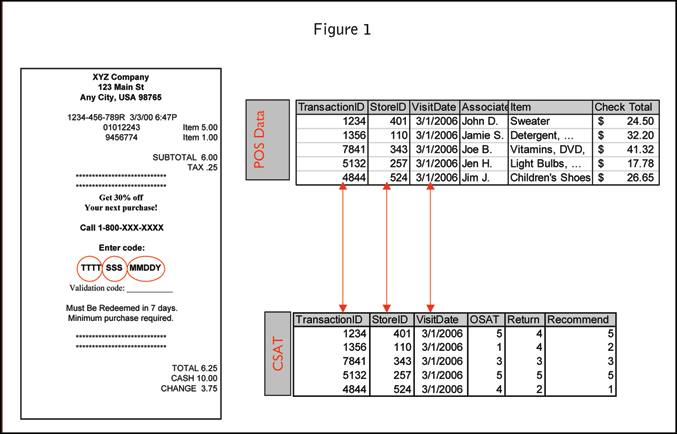
Start to understand
When we dig down to the individual transaction level, we can really start to understand how the service experience drives financial performance. Think back to an experience at Nordstrom or any retail store where you felt a genuine connection to the sales associate. Suddenly, instead of being sold merchandise, you find yourself working with an ally to find the items you are looking for. You may have come away from that experience spending more than you expected, yet you were also highly satisfied. As it turns out, you’re not alone.
In this first example (Figure 2), we see a major retailer who has five steps in their service model. When a customer experiences any of the steps in the service model they will spend between 15 and 39 percent more than if they don’t experience that particular service behavior. In this case, the strongest drivers of transaction value are offering the customer a credit card and the step that asks an associate to share their own experience about a product or service.
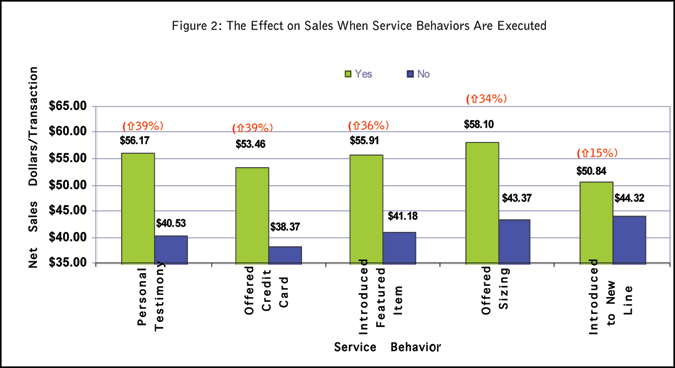
There’s an even more powerful effect for this retailer, however, when they begin to combine the individual behaviors in the model to create an entire service experience. You can see in Figure 3 that the transaction value more than doubles, on average, between customers who do not experience any part of the service model and those who experience all five service behaviors. Clearly, it is critical for this retailer to make sure that every associate understands the service model and is able to execute all behaviors associated with it.
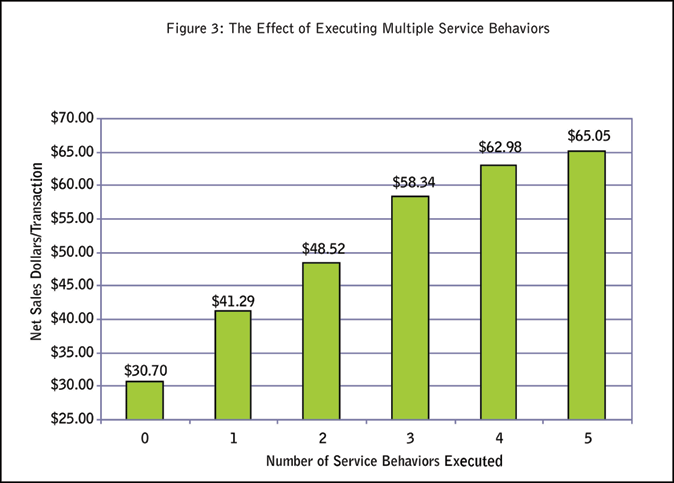
More not always better
We have seen that proper execution of service behaviors can positively impact sales immediately through increased retail purchases. However, executing more service behaviors may not always be better for the bottom line. Instead, the right behaviors at the right time may have a bigger impact. To illustrate, we need to look not only at incremental sales but also at customer conversion rates. Most retailers do not have the luxury of staffing budgets that would allow for 30-minute interactions with every customer who walks in the door. In addition to training associates to execute service behaviors, it is also important to teach them how to break away appropriately so that all customers receive assistance.
While creating the “ultimate” customer experience is great for many reasons, most retailers need to balance this with the need to touch multiple customers with a limited staff. The most effective way to achieve this balance is to prioritize service behaviors. Figure 4 shows conversion rates and average ticket amounts by the number of service behaviors executed. For this company, conversion is most impacted by getting the customer into the fitting room. The key is to maximize incremental sales with service behaviors without sacrificing conversion. Foundational behaviors that assist customers in getting into the fitting room need to be implemented and executed consistently before targeting additional behaviors that drive incremental sales.
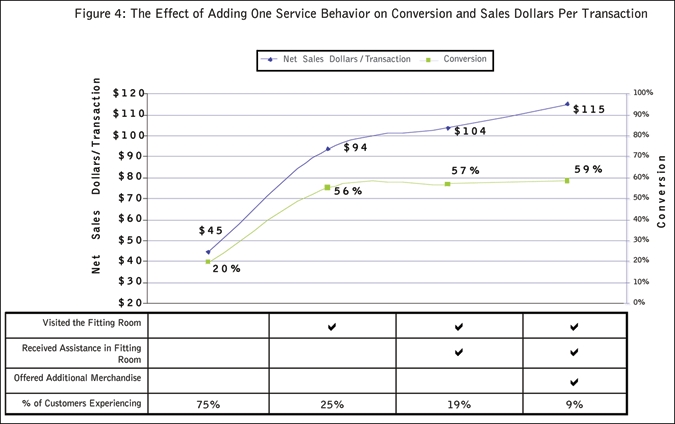
Immediate payoff
These examples illustrate that there is an immediate payoff if companies can get their associates to create the kind of service experience they want. However, does the increased transaction value come at the cost of customer satisfaction and future purchases? Not necessarily. When we examine the link between service behaviors and customer satisfaction, we again find that the more service behaviors exhibited, the more likely customers are to be “highly satisfied” with their overall experience (see Figure 5).
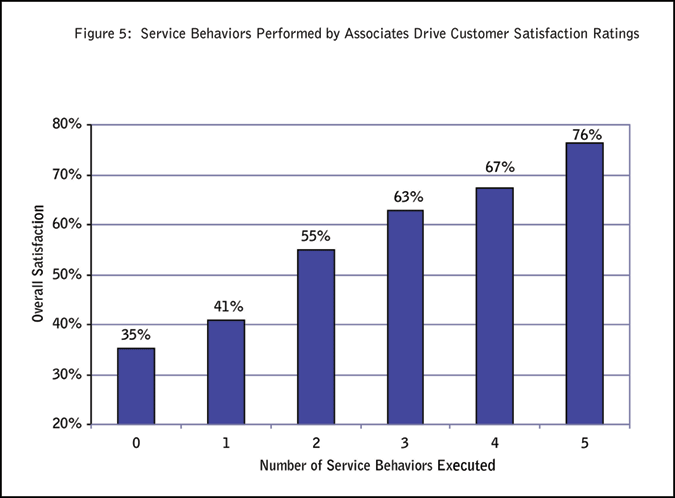
According to The Service Profit Chain (Heskett, Sasser and Schlesinger, 1997), the more satisfied customers are, the more likely they are to be converted into loyal customers. Customer loyalty is operationalized on many satisfaction surveys as the customer’s intention to return (repurchase) and the customer’s intention to recommend (positive word-of-mouth). A consistent finding across all of the retailers we study is that customers who rate their overall satisfaction in the top box (highly satisfied) are much more likely to intend to return to a particular retail outlet or recommend that outlet to friends and family. A typical loyalty curve plots satisfaction scores against customers’ loyalty intentions (see Figure 6). In this example, highly-satisfied customers are almost 25 percent more likely to indicate they are highly likely to return than merely satisfied customers and over 175 percent more likely than dissatisfied and highly-dissatisfied customers.
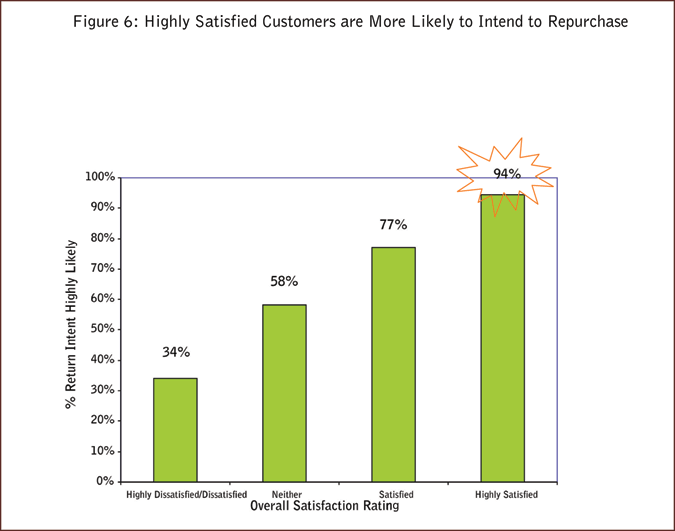
Because the difference between merely satisfied and highly satisfied customers impacts their loyalty intentions so strongly, service behaviors that can motivate customers to indicate they are highly satisfied will pay dividends in customer loyalty. But do intentions to return actually predict a customer’s true likelihood to return? Again, transactional data can be used to find the answer. When aggregating intent to return to the unit level and examining the relationship with comp-sales, we have to contend with a lot of noise in our model. Differences in store-level characteristics like convenience of location, competition and store volume may affect the relationship between the average intentions of all customers to return and actual comp-sales numbers. Fortunately, transactional data allows us to examine a customer’s intent to return in relation to whether he or she actually returned.
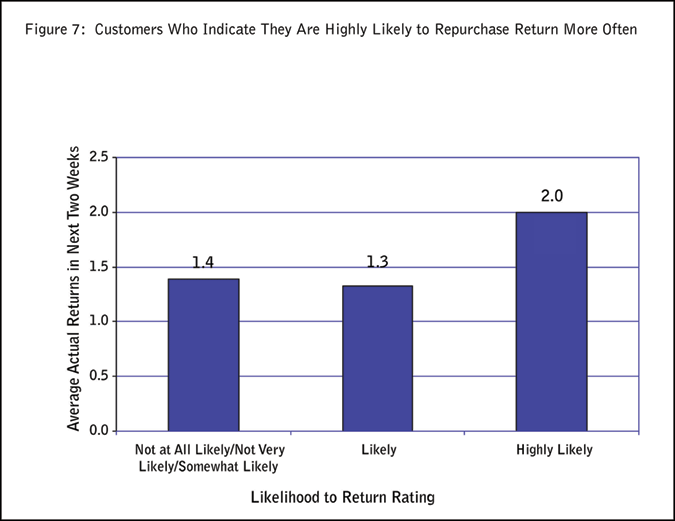
Figure 7 shows the relationship between a customer’s intent to return and their actual likelihood of returning. We used transactional data that uniquely identified customers via loyalty card numbers to link survey results to actual return visits. On average, customers who said they were highly likely to return came back twice in the two weeks following the visit for which they took the survey. All other respondents returned, on average, less than 1.5 times. Although this difference may first appear small, getting customers to visit one additional time per month could have large impacts on sales growth. Clearly, customer intentions are distinct from their behaviors but transactional analyses allow us to link the relationship between the two. In the absence of behavioral data, customer intentions can be used successfully to evaluate the potential impact on comp-sales by increasing the likelihood that a customer will return.
Cut through the clutter
The service experience matters. We all fundamentally understand that, but proving it can be a challenge. Transactional level data allows us to cut through the clutter often associated with linking the store-level customer experience with store-level financial results. Transactional analysis demonstrates clearly that those customers who experience a well-developed service model and have genuine interaction with sales associates not only spend more but are more likely to come back again. Linking customer survey data to transactional data provides organizational decision makers with an opportunity to evaluate which service behaviors have the biggest impact on customer satisfaction, customer loyalty and financial performance for their brand. After the right behaviors have been identified, continuous measurement of customer service delivery through a well-designed customer satisfaction survey will ensure that consistent execution continues.
References
Berry, Leonard L., Wall, Eileen A. and Carbone, Lewis P. “Service Clues and Customer Assessment of the Service Experience: Lessons from Marketing,” The Academy of Management Perspective, 20, 2006: 43-57.
Davenport, Thomas H. and Harris, Jeanne G. Competing on Analytics: The New Science of Winning. Boston: Harvard Business School Press, 2007.
Frei, Frances. “Breaking the Trade-off between Efficiency and Service,” Harvard Business Review, November, 2006.
Heskett, James L., Sasser, W. Earl, and Schlesinger, L.A., The Service Profit Chain. NY: The Free Press, 1995.
Wharton Business School, “Are Your Customers Dissatisfied? It May be Time to Check-out Your Salespeople,” http://knowledge.wharton.upenn.edu/article.cfm?articleid=1735, 2007.
